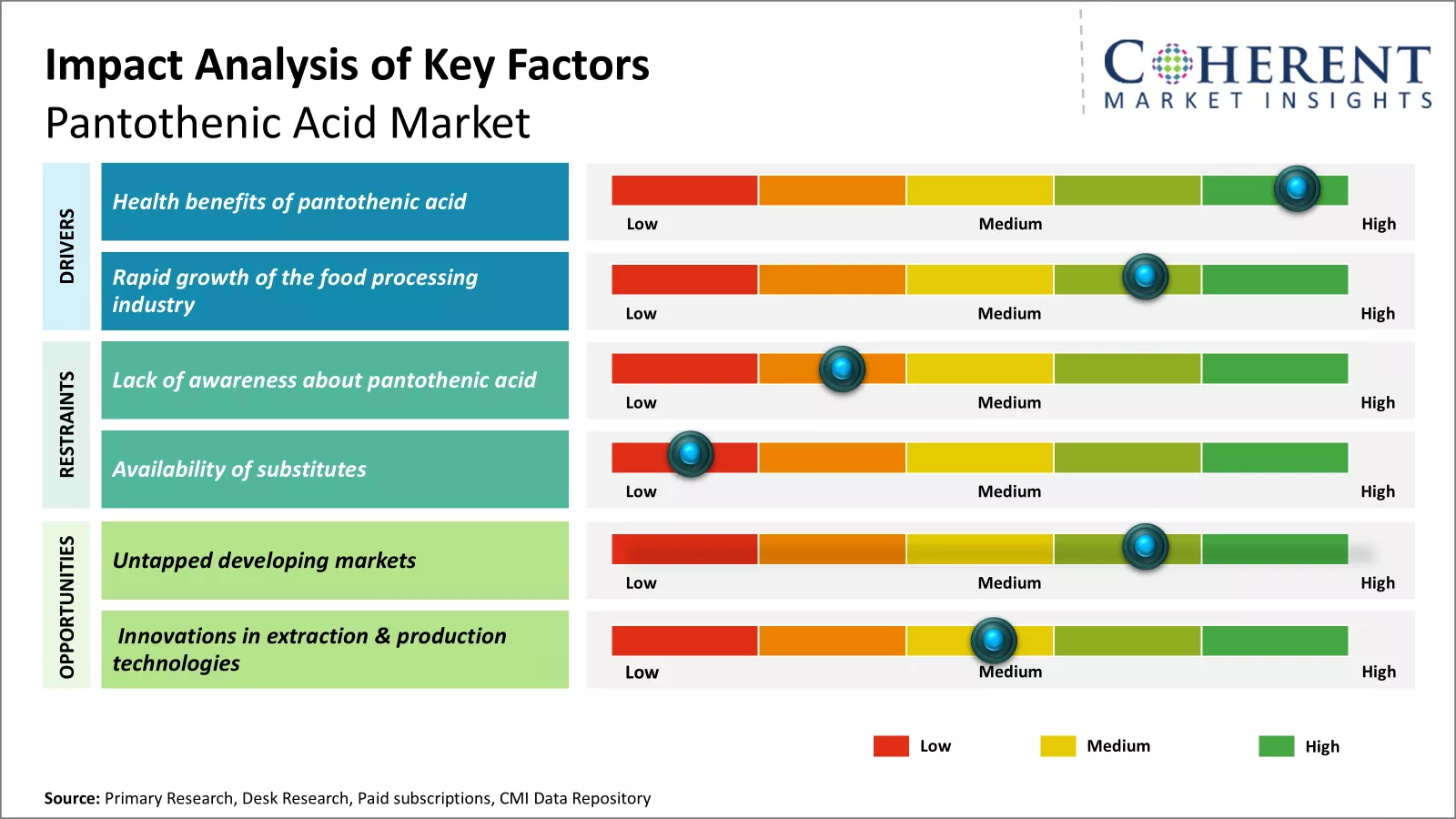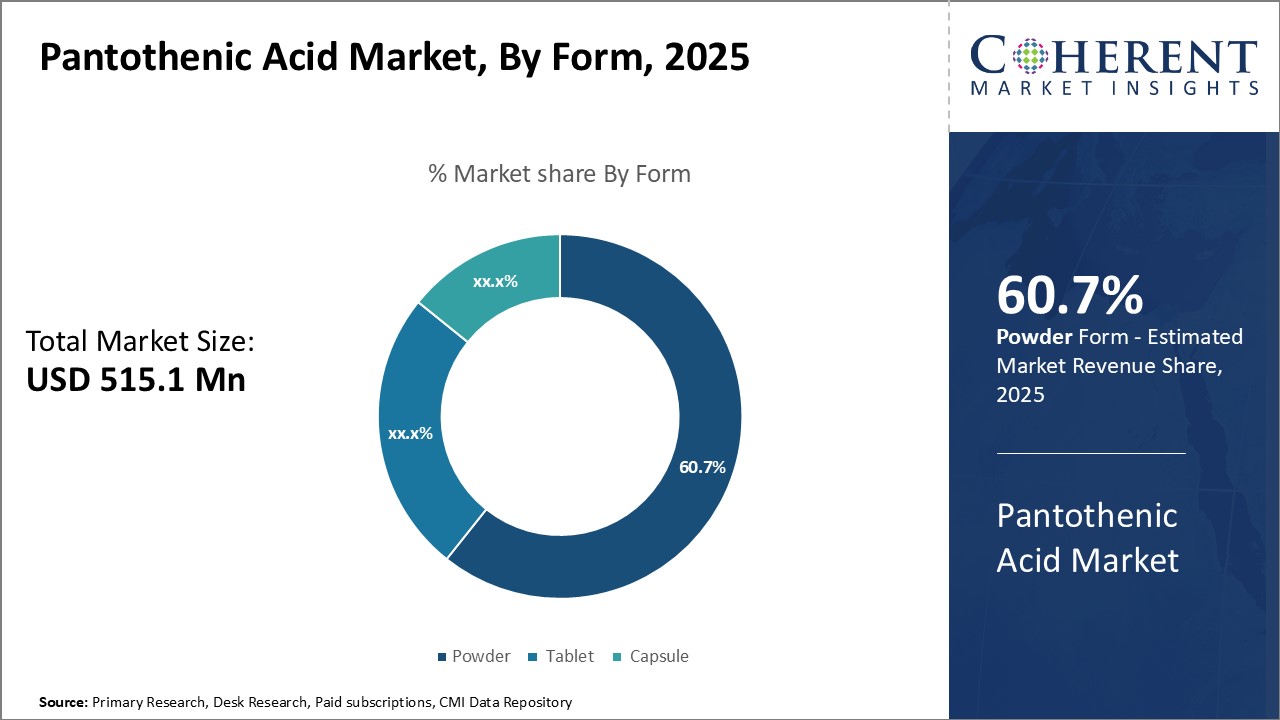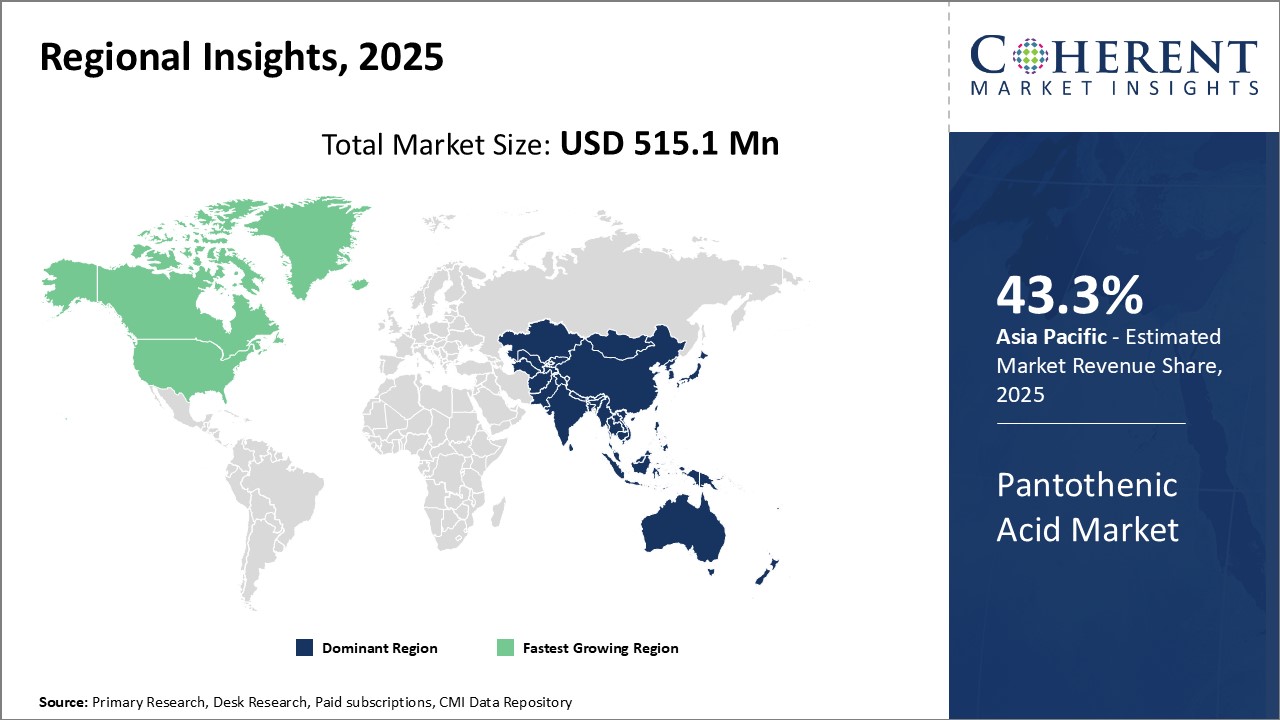Pantothenic acid market is estimated to be valued at USD 515.1 Mn in 2025 and is expected to reach USD 838.6 Mn by 2032, exhibiting a compound annual growth rate (CAGR) of 7.2% from 2025 to 2032.

Discover market dynamics shaping the industry: Download Free Sample
There has been huge demand for pantothenic acid due to its wide applications in industries like food & beverages, pharmaceutical, and cosmetics. It is widely used as a nutrient and supplement in various food products such as energy drinks, nutritional supplements, and infant formula. Rising health consciousness among individuals has boosted the consumption of dietary supplements containing pantothenic acid. Growing personal care and cosmetics industry can also drive the growth of the market as it is used in anti-aging creams and moisturizers. Growing vegan population has also boosted demand for pantothenic acid supplements. Increasing cognizance about the benefits of pantothenic acid in maintaining overall health and well-being can offer lucrative opportunities for this market over the forecast period.

Discover high revenue pocket segments and roadmap to it: Download Free Sample
Insights, By Form- Market Overview of Pantothenic Acid in Powder Form
In terms of form, powder segment is estimated to contribute the highest market share of 60.7% in 2025, owing to its easy consumption options. Powder forms of pantothenic acid can easily be added to drinks, smoothies, and various food recipes providing the convenience of consumption. Powder dissolves readily than tablet or capsule, which makes absorption easier. This is beneficial for individuals who have difficulty in swallowing tablets. Furthermore, powder is affordable to manufacture and transport as compared to bulkier capsule or tablet form. This provides powder form a cost advantage over other forms.
Insights, By Nature- Consumer Preferences and Health Consciousness
In terms of nature, plants segment is estimated to contribute the highest market share of 36.7% in 2025, due to consumer preference for natural sources. Many health-conscious consumers desire plant-based pantothenic acid due to the perception of greater safety associated with natural substances. Plants are seen as more sustainable and environment-friendly sources in comparison to animal sources. Furthermore, plant-based pantothenic acid is considered suitable for vegans and vegetarians who avoid consumption of animal products. This widespread acceptance and demand for natural plant sources can drive the plants segment growth.
Insights, By End-use Industry- Pharmaceuticals' Medical Value
In terms of End-use Industry, pharmaceuticals segment is estimated to contribute the highest market share of 26.8% in 2025, due to pantothenic acid's clinical benefits. It plays a key role in various biochemical reactions in human body, and deficiency can cause health issues. Therefore, pantothenic acid has applications in the treatment of conditions like fatigue, stress, depression, ketosis, and others. Clinical studies have demonstrated its efficacy as supportive therapy. Growing healthcare needs and costs have boosted demand from pharmaceutical companies. Increasing health awareness among consumers regarding nutritional supplementation in daily diet can drive the segment growth.

Need a Different Region or Segment? Download Free Sample
Regional Analysis- Pantothenic Acid Market
Dominating Region- Asia Pacific
The Asia Pacific region is projected to lead the pantothenic acid market, capturing an estimated 43.3% share in 2025, fueled by a robust dietary supplement industry and heightened consumer awareness. Key players in this area have built their reputations through innovative product developments and strategic expansions across various countries. Additionally, supportive government policies that favor the natural ingredients sector are likely to further stimulate market growth.
Fastest-Growing Region- North America
The North America region is experiencing rapid growth driven by increasing health awareness among consumers and rising disposable incomes in emerging markets. A large population and a transition towards preventive healthcare are enhancing the adoption of pantothenic acid across various sectors.
Pantothenic Acid Market Outlook for Key Countries
U.S. - The U.S. market is characterized by a high level of unmet demand for premium health products. Leading players' innovation-driven business tactics can help them spread their franchise across the country.
China - China market have opportunity to expanded significantly over the past decade, due to the expanding middle-class consumer group and burgeoning e-commerce platforms.
Japan - Japan market leads in East Asia with a well-established dietary ingredients industry and focus on functional food items.
India - The potential for India market remains largely unexploited. However, Indian companies are beginning to introduce innovative local solutions to establish a presence in the market, especially in response to rapid urbanization.

Get actionable strategies to beat competition: Download Free Sample
Top Strategies Followed by Pantothenic Acid Market Players
Emerging Startups in the Pantothenic Acid Market
Innovative Technologies-
SynBio Technologies has developed a patented fermentation process to bio-produce pantothenic acid using non-pathogenic microbes. This ensures a sustainable supply of the vitamin and removes dependence on chemical synthesis. The technology could lower production costs and prices over the long run.
Sustainable Solutions-
Companies like Anthropic focuses on more environmentally friendly approaches. For example, the startup produces pantothenic acid using byproducts from the food industry that would otherwise become waste. This circular production method helps reduce agricultural waste and lower the industry's carbon footprint.
Key Takeaways from Analyst
Pantothenic Acid Market Report Coverage
| Report Coverage | Details | ||
|---|---|---|---|
| Base Year: | 2024 | Market Size in 2025: | USD 515.1 Mn |
| Historical Data for: | 2020 To 2024 | Forecast Period: | 2025 To 2032 |
| Forecast Period 2025 to 2032 CAGR: | 7.2% | 2032 Value Projection: | USD 838.6 Mn |
| Geographies covered: |
|
||
| Segments covered: |
|
||
| Companies covered: |
Nutrina Co Inc., Zhengzhou Sigma Chemical Co. Ltd., Cayman Chemical, CHEM-BRIDGE Co. Ltd., Foodchem International Corporation, Koninklijke DSM N.V., RxList Inc., NOW Health Group Inc., BASF SE, and AccuStandard Inc. |
||
| Growth Drivers: | Health benefits of pantothenic acid Rapid growth of the food processing industry |
||
| Restraints & Challenges: | Lack of awareness about pantothenic acid Availability of substitutes |
||
Uncover macros and micros vetted on 75+ parameters: Get instant access to report
Market Driver- Health benefits of pantothenic acid
Pantothenic acid, also known as vitamin B5, plays an important role in human health as it is involved in various metabolic functions within our body. It helps convert food into energy and is essential for the synthesis of hormones and cholesterol, hemoglobin formation and nerve transmission. A lack of pantothenic acid can cause fatigue, irritability, and stress, as this vitamin is essential for the production of acetylcholine—a neurotransmitter that regulates many vital bodily functions. This concern is heightened by the increasing global prevalence of non-communicable diseases such as diabetes. According to data released by the World Health Organization in April 2023, a growing number of consumers are anticipated to seek out supplements that contain pantothenic acid to aid in blood glucose management and enhance metabolic health. It also aids in the absorption of essential minerals like iron, calcium, and magnesium. Since pantothenic acid is necessary for cholesterol synthesis, it plays a supporting role in maintaining healthy cortisol and sex hormone production.
Market Challenge- Lack of awareness about pantothenic acid
While pantothenic acid is an essential vitamin that supports various metabolic activities in the human body, there has been general lack of awareness regarding it among consumers. In March 2021, a report from the National Institutes of Health (NIH) outlined that the Dietary Reference Intakes (DRIs) for pantothenic acid and other nutrients are established by the Food and Nutrition Board (FNB) at the National Academies of Sciences, Engineering, and Medicine. The Recommended Dietary Allowance (RDA) represents the average daily intake level necessary to satisfy the nutrient needs of nearly all (97%–98%) healthy individuals and is often utilized for planning nutritionally adequate diets. Majority of consumers remain unfamiliar with the dietary sources and health benefits of pantothenic acid. This lack of awareness poses challenge for this market as consumers may not actively seek pantothenic acid supplements or fortified products.
Market Opportunity- Untapped developing markets
Global pantothenic acid market can witness growth opportunities due to developing markets of the world. In developed regions such as North America and Western Europe, there are well-established consumer markets for various vitamins and supplements. However, emerging economies have seen limited penetration and awareness regarding these products. For instance, in 2021, as per the report published by NIH, countries in Asia Pacific like India, Indonesia, and Philippines currently have low pantothenic acid consumption levels as compared to developed nations. This region alone accounts for over 60% of the world's undernourished people, according to the UN Food and Agriculture Organization. As their standard of living enhances, there will be huge demand for pantothenic acid and other vital vitamins and minerals.
Share
Share
About Author
Kalpesh Gharte is a senior consultant with approximately 5 years of experience in the consulting industry. Kalpesh holds an MBA in Operations and Marketing Management, providing him with a strong foundation in market strategy and analysis. He has contributed to various consulting and syndicated reports, delivering valuable insights that support informed business decisions
Missing comfort of reading report in your local language? Find your preferred language :
Transform your Strategy with Exclusive Trending Reports :
Frequently Asked Questions
Joining thousands of companies around the world committed to making the Excellent Business Solutions.
View All Our Clients